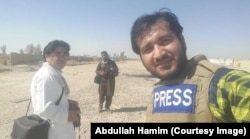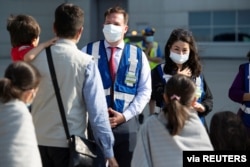The shrapnel from a Taliban car bombing next to his commuter bus in Kabul on January 20, 2016, hit Hassib Sadaat in the head and face, sending him to the emergency room and leaving permanent scars. Now, the Taliban recognize this Afghan journalist who survived their deadly attack.
"I've quit reporting on current affairs," Sadaat told VOA from Kabul, "and now do only sports news. The scars on my face attract the Taliban’s suspicion.”
The shift in his beat is a risk-mitigating effort in a country run by the Taliban, who have imposed strict censorship on the media.
In the 2016 Taliban attack, seven TOLOnews employees were killed, and several others were wounded. The Taliban had accused TOLOnews, a private channel owned by an Australian-Afghan family, of misreporting the Taliban's actions when the group briefly took Kunduz city in the north of Afghanistan in September 2015.
When Taliban fighters entered Kabul last year, dozens of journalists joined tens of thousands of other Afghans who scrambled their way to the Kabul airport to board U.S. military planes and leave their country.
Sadaat and several other journalists who could not make it to the airport now allege the evacuation of media personnel from Afghanistan was mired in irregularities, abuse and potential fraud.
"I worked for TOLOnews for more than eight years in the most insecure parts of the country in the south, but I was dropped from the evacuation," Abdullah Hamim, a reporter, told VOA, adding that the channel's executives told him he could survive the Taliban because of his ethnic ties to the group leadership.
But the Taliban pursued Hamim, forcing him to flee to Pakistan last year where he has applied to U.S. and Canadian embassies for humanitarian resettlement.
"I've lost hope … nobody cares about us here," the young reporter said.
Media lists
The sudden fall of the former Afghan government precipitated a chaotic evacuation of Western citizens and at-risk Afghans, including journalists and civil society activists. The U.S. airlifted more than 124,000 people from the Kabul airport from August 15 to 31.
At first, anyone who could get to the runway could board a plane. But later, lists of individuals were developed to ensure certain groups of people who were facing imminent harm from the Taliban would get out of the country.
There were also lists of known journalists who needed to be evacuated, according to Parwiz Shamal, a senior journalist with TOLOnews who had left the country before the Taliban seized power.
About 119 TOLOnews personnel managed to board evacuation planes. But not all were journalists — one senior manager had his extended family evacuated, Shamal and two other journalists alleged.
Reza Moini, head of the Iran-Afghanistan desk at Paris-based Reporters Without Borders (RSF) who was involved in the efforts to evacuate Afghan journalists, said there were some lists of journalists recommended for evacuation.
"But ultimately it was the governments that decided the evacuation process, and the RSF had no influence over that," Moini said, adding that his organization had sent a list of 150 journalists to Western embassies for the evacuation.
A TOLOnews manager involved in the evacuation process did not respond to requests for comment, but Hasiba Atakpal, a TOLOnews reporter who left the country last August and resettled in Virginia, said the evacuation was executed appropriately.
"Some of our colleagues might be disappointed because they're still stuck in Afghanistan, but overall, the process was handled effectively," said Atakpal, adding that during the evacuation, journalists were receiving text messages from Western embassies to get to the airport, and it was not clear why some of her colleagues, despite their names being on the evacuation lists, were left out.
Protests in Islamabad
Left out of the evacuation and facing threats inside Afghanistan, dozens of Afghan journalists have traveled to Pakistan’s capital, Islamabad, where they have staged protests calling on the U.S. and Canadian embassies to help with their resettlement.
"I have lost hope in the P-2 process," said Sulaiman Mosazai, an Afghan journalist with 1TV, describing the Priority-2 U.S. resettlement program. "I've been living in Islamabad for more than nine months with so many economic and social problems, and yet I have no clue about my P-2 case," he added.
Canada, which has admitted more than 17,000 Afghan refugees since August 2021, has offered to take in Afghan journalists and their families.
"Immigration, Refugees and Citizenship Canada (IRCC) takes allegations of fraud very seriously and recognizes that the situation in Afghanistan may make individuals more vulnerable to fraud," Nancy Caron, a spokesperson for IRCC, told VOA.
"Our commitment of bringing at least 40,000 vulnerable Afghans to Canada has not waivered," Caron said, but she did not specify how many journalists would be among them.
The Afghan media, once dubbed the most promising achievement of U.S.-led development in Afghanistan, has dissipated under Taliban rule.
Dozens of TV and radio channels and print media have gone out of business, and more than 2,000 of the estimated 4,000 Afghan journalists (pre-2021) have left the country, according to a report by the Afghanistan National Journalists Union in February.
In just one year under the Taliban, Afghanistan has plunged 34 ranks in the 2022 RSF World Press Freedom Index, from 122 in 2021 to 156 in 2022.
"With the collapse of the Afghan government on August 15, the free media also collapsed in Afghanistan," said Anisa Shaheed, a prominent Afghan journalist who has resettled in the U.S. "There is only one media in Afghanistan now, and that serves the Taliban regime."
Taliban officials, however, reject such criticisms and say media can operate in the country within the parameters of Islamic values.












